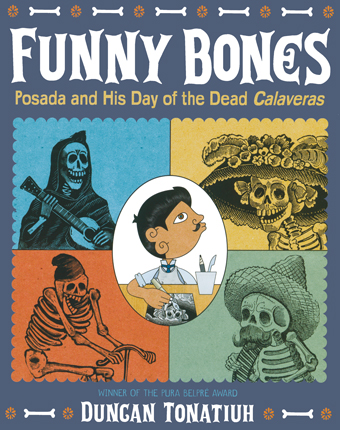| Funny bones : Posada and his Day of the Dead calaveras Author: Tonatiuh, Duncan | ||
| Price: $23.98 | ||
Summary:
Jose Posada was a Mexican artist whose skeleton drawings are emblematic of Mexico's Dia de los Muertos. Explores the life of the man who created these iconic images.![]() Download a Teacher's Guide
Download a Teacher's Guide
| Accelerated Reader Information: Interest Level: LG Reading Level: 5.10 Points: .5 Quiz: 178804 | Reading Counts Information: Interest Level: 3-5 Reading Level: 5.30 Points: 3.0 Quiz: 71100 | |
Awards:
Robert F. Sibert Informational Book Award, 2016
Reviews:
Kirkus Reviews (+) (06/15/15)
School Library Journal (+) (09/01/15)
Booklist (+) (07/01/15)
The Bulletin of the Center for Children's Books (00/10/15)
The Hornbook (+) (00/11/15)
Full Text Reviews:
Booklist - 07/01/2015 *Starred Review* This exceptional picture-book biography profiles Mexican artist José Guadalupe Posada (1852–1913), who is remembered primarily for his portrayal of calaveras, the droll skeletons prominent in Día de Muertos (Day of the Dead) celebrations. Posada, who loved to draw as a child, later discovered printmaking, the art form that would shape his career. He learned lithography, engraving, and etching, three techniques that are succinctly explained here and illustrated through cartoonlike panels of drawings. As an adult, then known as Don Lupe, Posada’s images of calaveras amused the public by poking fun at politicians. In the second half of the book, every other page reproduces a Posada print and asks a question, such as, “Was Don Lupe saying that . . . even powerful leaders one day become calaveras?” The use of questions works well, encouraging readers to engage with the art, while the clearly written narrative continues on the facing pages. Appearing throughout the book, Tonatiuh’s illustrations are digital collages notable for their controlled energy, vibrant colors, and a wonderfully rhythmic arrangement of forms on the page. The final scene, a witty, updated version of grinning calaveras, depicts them as young people today. Playful but informative, this picture book offers a fascinating introduction to the artist and his work. - Copyright 2015 Booklist.
School Library Journal - 09/01/2015 Gr 3–6—Tonatiuh's latest delves into the life of artist and social commentator extraordinaire José Guadalupe Posada, best known for his literary calaveras, brief and amusing rhyming poems about skeletons dressed in clothes, going about their daily business. The beautifully expressive Day of the Dead-inspired illustrations on heavy paper pages sport borders of bones, grinning skeletons, and Tonatiuh's signature figures shown in profile, influenced by the ancient Mexican art of his ancestors. Simple yet effective sentences accompany step-by-step images detailing the artistic processes that Posada learned as a printer's apprentice: lithography, engraving, and etching. Reproductions of Posada's calaveras will help children appreciate Posada's passion for his profession, such as the broadside "Calavera Love," which depicts a gentleman skeleton proposing marriage; the poem concludes, "I am sorry, Señor. But that cannot be./You're handsome and all,/but too skinny for me!" Tonatiuh explains the poetry, posing questions about the artist's intentions and adding historical context, explaining the calaveras that Posada created in response to the Mexican Revolution. Extensive back matter includes links where students can see Posada's original work and an author's note that suggests using the calaveras "to learn and celebrate el Dia de Muertos." VERDICT A stunning work, with great possibilities for lesson plans or tie-ins with Day of the Dead.—Toby Rajput, National Louis University, Skokie, IL - Copyright 2015 Publishers Weekly, Library Journal and/or School Library Journal used with permission.



